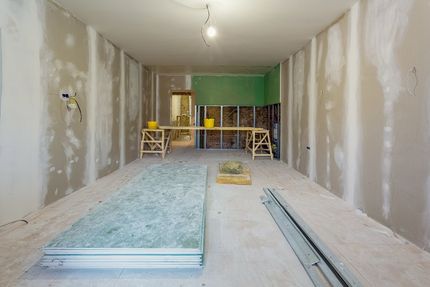Quality Drywall Installation That Transforms Your Interiors
Quality Drywall Installation That Transforms Your Interiors
Blog Article
Total Overview to Effective and Trustworthy Drywall Setup
Drywall installment is an important component of any construction or restoration task, demanding a meticulous strategy to ensure both effectiveness and dependability. It is vital to explore the subtleties of each action in the procedure, as they jointly contribute to the total success of the drywall installment.
Vital Tools for Drywalling
When embarking on a drywall installment job, having the right devices is important for attaining a specialist finish. Essential tools include a drywall blade, measuring tape, and a T-square, which are essential for exact measurements and smooth cuts. A drywall lift is additionally highly valuable, particularly for ceiling installments, permitting simpler handling of heavy panels.
For fastening the drywall, a cordless drill and drywall screws are needed. The drill must be furnished with a drywall little bit to guarantee efficiency and accuracy. Additionally, a key device is the drywall saw, which facilitates reducing around electrical outlets and various other barriers.

Additionally, safety equipment such as shatterproof glass and a dirt mask are crucial to ensure individual security during the setup procedure. Using the right tools not just improves the quality of the installment but additionally enhances the operations, making the project a lot more efficient overall.
Preparing the Area

Following, examine the problem of the ceilings and walls. Fix any existing damage, such as openings, splits, or peeling paint, to ensure a smooth and even surface for drywall application. In addition, check for electrical outlets, plumbing lines, and HVAC ducts, marking their locations to avoid complications during installation.
It is additionally important to determine the area precisely, figuring out the dimensions of the ceilings and walls to determine the appropriate amount of drywall required. Produce a comprehensive strategy that consists of the format and orientation of the drywall panels.
Installation Strategies
Reliable setup methods are vital for achieving an expert coating in drywall projects. Proper measurement and cutting of drywall sheets are essential steps. Always determine the wall area accurately, allowing for any type of buttons or outlets. Make use of an energy blade for clean cuts, scoring the paper face and breaking the board along the scored line.
When hanging drywall, start from the leading and job downward, ensuring that the long side of the board is perpendicular to the framework. Safeguard the sheets with screws as opposed to nails, which provide higher holding power and lower the danger of popping. Location screws every 12 inches along the sides and every 16 inches in the area of the board.
For edges, use edge beads to accomplish sharp, tidy edges. When mounting on ceilings, make use of a drywall lift or have a partner help in holding the sheets in place (drywall contractor). Maintain a gap of regarding my explanation 1/4 inch above the floor and ceiling to accommodate expansion and contraction
Completing Touches

Begin by applying joint tape over the joints. This can be either paper or fiberglass mesh tape, with paper being liked for its toughness. When the tape is in area, it's time to apply the very first coat of joint substance, additionally known as mud. Make use of a 10 to 12-inch taping blade to spread out the compound uniformly over the taped joints, feathering the edges to mix with the surrounding drywall.
Enable the substance to dry completely, generally 1 day. After drying out, sand the surface area gently view publisher site with fine-grit sandpaper to get rid of any imperfections. drywall installation. Repeat the mudding and fining sand procedure, typically a couple of layers, making sure each layer is flush and smooth with the drywall surface area
Common Mistakes to Stay Clear Of
Many Do it yourself lovers encounter risks during drywall setup that can compromise the last results. One usual blunder is falling short to correctly cut and gauge drywall sheets.
One more constant error is inappropriate attachment. Using also few screws or nails can lead to loose drywall, while overdriving bolts can trigger the paper to tear, damaging the framework. It's vital to keep constant spacing, commonly every 16 inches, and to make certain that bolts are flush with the surface.
Furthermore, not attending to wetness issues prior to setup can result in mold and mildew development and structural damages. Constantly evaluate the atmosphere and use moisture-resistant drywall in high-humidity locations.
Verdict
Reputable and efficient drywall installation requires careful attention to detail throughout the process. By utilizing necessary tools, preparing the area properly, and sticking to ideal methods in setup strategies, a perfect surface can be accomplished. Furthermore, cautious application of joint compound and tape during the ending up phase improves toughness and appearance. Avoiding typical errors further adds to a specialist outcome, underscoring the importance of precision and technique in successful drywall jobs.
It is important to discover the nuances of each action in the procedure, as they jointly contribute to the general success of the drywall installation.When getting started on a drywall setup task, having the right tools is essential for achieving a specialist finish.For securing the drywall, a cordless drill and drywall screws are essential.Correctly preparing the room is vital for a successful drywall installation.Effective setup techniques are critical for achieving a professional surface in drywall jobs.
Report this page